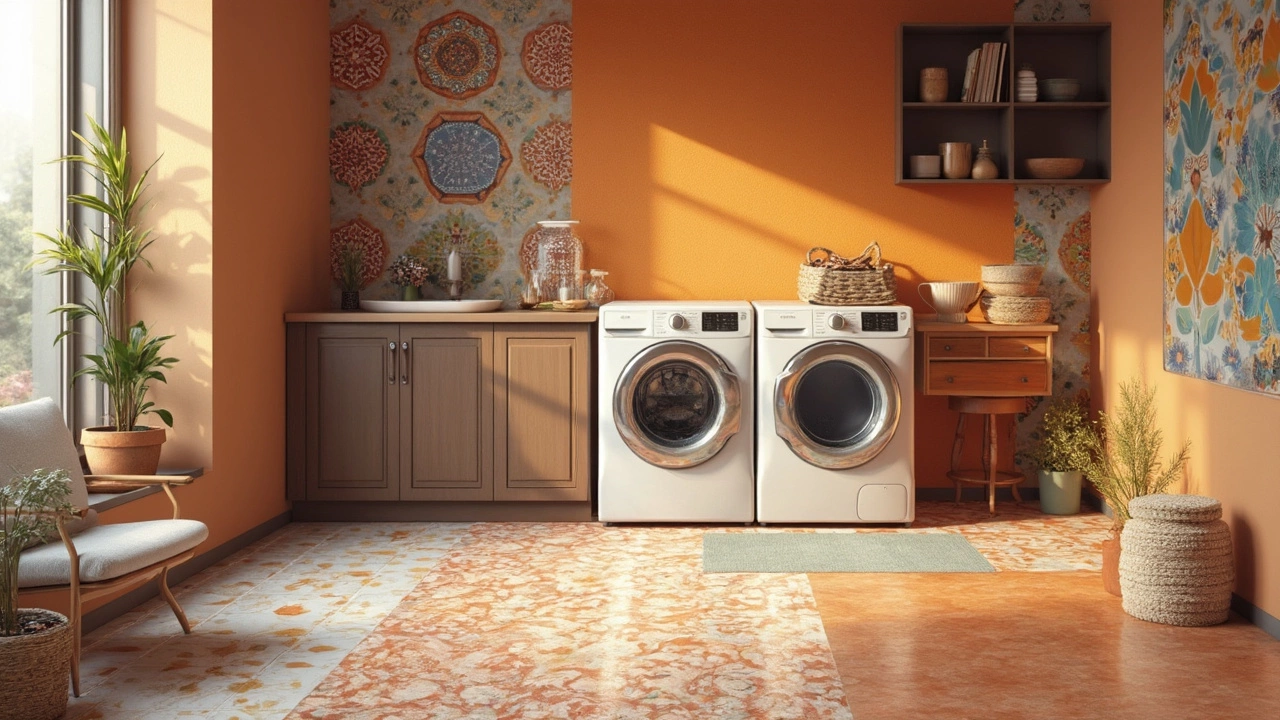
If you've recently moved into a new home or are just looking to upgrade your laundry setup, you might be wondering about the necessity of flooring beneath your washer and dryer. It's not as straightforward as you might think. The flooring plays a key role in vibration absorption, noise reduction, and even resale value for your home.
First off, let's talk about the kinds of flooring you might consider. Tiles and vinyl are popular options—they're water-resistant and easy to clean, which are big pluses in a laundry room. However, some folks swear by specific high-durability materials that stand the test of frequent use.
But there's more than just material to think about. Installation can be a bit tricky. It might seem simple, but there are tips and tricks to make sure everything is even and secure, ensuring it lasts for years to come. Plus, you'll want to avoid costly mistakes that might lead to having to redo the entire setup.
Why Flooring Matters
So, you might be asking yourself, why all the fuss about having flooring under a washer and dryer? Honestly, it's more crucial than most people think. Imagine having your washer shake and rattle every time you start a spin cycle; that's where good flooring makes its entrance.
First up, vibration control. When a washer is placed directly on uneven or weak flooring, it can amplify the noise and might even walk across the room over time. A solid flooring option like tile or vinyl can help dampen those vibrations, making laundry day a little less chaotic.
Next, let's talk about water damage. Laundry rooms are hotspots for spills and leaks. It doesn’t matter how careful you are; it's going to happen sooner or later. By installing water-resistant flooring, you'll save yourself from unexpected headaches and repair bills. It’s like having insurance for your floors.
Another point: ease of cleaning. Ever tried cleaning a carpet after a detergent spill? Not fun. Hard surfaces are just easier. A quick mop, and voila, as good as new. So, if you're into low-maintenance living, this is a no-brainer.
Boosting Resale Value
This might come as a surprise, but proper flooring can actually enhance your home's resale value. Potential buyers often look at laundry rooms as a sign of overall home care. A well-installed flooring shows you've put in the effort, and that could translate into a better offer when you're ready to sell.
In this simple decision, you're making an investment. With top-notch flooring under your kitchen appliances, you're setting yourself up for less trouble and more convenience. Plus, who doesn't want to enjoy a tad more peace and quiet while laundry machines whirl away?
Best Flooring Materials
Choosing the right flooring for under your washer and dryer can make a world of difference. The key is to prioritize both functionality and style while taking into account the unique demands a laundry area presents.
1. Tiles: A Classic Choice
When it comes to durability and water resistance, tiles are a solid option. They come in all sorts of styles and colors, allowing for a lot of customization. Porcelain tiles are particularly popular because they're tougher and more resistant to moisture compared to ceramic options.
2. Vinyl Flooring: Budget-Friendly and Effective
Vinyl flooring is like the unsung hero of laundry rooms. It's affordable, easy to install, and great for resisting spills and moisture. Vinyl can mimic the look of wood or stone without the hefty price tag, making it a versatile choice.
3. Concrete: The Industrial Look
If you're into the industrial vibe, concrete flooring could be your go-to. It's incredibly durable and can handle the heavy weight of washers and dryers. Plus, when sealed properly, it becomes quite water-resistant. Some people even like to paint or stain concrete for an extra level of customization.
4. Laminate: Style Meets Function
Combining aesthetics with practicality, laminate flooring offers a great finish and is relatively easy to clean. However, it's essential to ensure it's waterproof to handle any leaks or spills from the washer and dryer.
How to Choose?
- Think about your budget: Some materials cost more upfront but save you in maintenance and longevity.
- Prioritize durability: Your appliances move, vibrate, and, well, leak once in a while.
- Consider maintenance: How much time you want to spend cleaning or fixing any issues?
- Look at your home's style and resale value: Does the flooring fit with the rest of your home? Will future buyers appreciate it?
Picking the right flooring is more than just making your laundry room look nice. It’s about providing a stable, durable base for your appliances, and saving money long-term with the right choice. Equip yourself with this knowledge to make an informed decision, and your floors, wallet, and home will thank you.

Installation Tips
Thinking about adding flooring under your washer and dryer can feel a tad overwhelming, but it helps to get a grip on some basic installation tips. First things first, you’ll need the right tools and a solid plan.
Get Your Tools Ready
Start by gathering necessary items like a tape measure, level, utility knife, and adhesive. It’s also handy to have a carpenter square for precision.
Measuring and Cutting
Accuracy is king when you're cutting flooring. Measure the space carefully and double-check before making any cuts. Use a utility knife for materials like vinyl, or a saw for harder materials like tile, ensuring clean edges.
Prepare the Subfloor
Before laying any new flooring, make sure the subfloor is smooth and dry. This might mean a little bit of sanding or cleaning up debris. A well-prepped surface ensures that your flooring under your washer will last longer and stay in place.
Start from the Center Out
It often works best to start installing from the center and move outwards. This technique helps in minimizing visible seams and keeps everything even, especially if you're dealing with tiles.
Adhesive Application
Apply adhesive as per the flooring type—spread evenly and work in small sections to avoid a sticky mess. Press firmly to bond the flooring efficiently. With resilient materials like vinyl tiles, always roll the floor to remove air pockets.
Sealing the Edges
Seal the edges to keep moisture out. Using a waterproof sealant around the edges can save you headaches down the line.
| Flooring Material | Average Cost | Durability Level |
|---|---|---|
| Vinyl | $1-$3 per sq. ft. | Moderate |
| Tile | $4-$10 per sq. ft. | High |
| Laminate | $2-$5 per sq. ft. | Moderate |
Whether it's vinyl or other materials, proper installation is clutch. A bit of prep time can prevent costly do-overs and keep your setup sleek and efficient. You got this!
Pros and Cons
When you're deciding whether to put flooring under your washer and dryer, weighing the pros and cons can make your decision a whole lot easier. Let's break it down so you know exactly what you're getting into.
Pros of Flooring Under Washer and Dryer
- Vibration and Noise Reduction: A sturdy flooring option like tiles or vinyl can level out your appliances, cushioning them to minimize noise and vibration. This is particularly useful if your laundry room is located near your living area.
- Resale Value: Homes with clean, well-installed and durable floors, especially in functional spaces like laundry rooms, can fetch a better price. Potential buyers appreciate the attention to detail.
- Water Resistance: Opting for flooring materials that are water-resistant like tiles means there's less worry about accidental leaks damaging your home's structure or causing mold.
Cons of Flooring Under Washer and Dryer
- Cost: Good flooring can be pricey, and let's face it, those costs add up. If your budget's tight, it might be tempting to put this project on hold.
- Installation Hassles: Installing flooring under heavy appliances can be a labor-intensive task. It often requires professional help to do it right—more time, more cash.
- Maintenance: Flooring, though low-maintenance, still requires some care and attention to keep it looking good and functioning well. If you spill something or there's a leak, immediate clean-up is essential to prevent damage.
To give you a quick overview, here’s a little breakdown comparing a couple of flooring types you might consider under your washer and dryer:
| Flooring Type | Water Resistance | Installation Cost |
|---|---|---|
| Tile | High | Medium to High |
| Vinyl | High | Low to Medium |
Making the call boils down to what's best for your space, budget, and future plans. Just keep in mind that the right flooring not only helps your appliances work better but also boosts the overall vibe of your home.